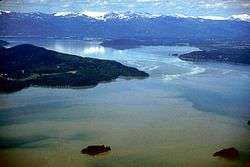Pend d'Oreilles
 Touch Her Dress, a Kalispel girl, ca. 1910 | |
| Total population | |
|---|---|
| over 400 | |
| Regions with significant populations | |
|
( | |
| Languages | |
| Kalispel-Pend d’Oreille, English[1] | |
| Religion | |
| traditional tribal religion | |
| Related ethnic groups | |
| Chewelah,[2] Spokane |
The Pend d’Oreilles, also known as the Kalispel, are Indigenous peoples of the Northwest Plateau. Their traditional territory was around Lake Pend Oreille, as well as the Pend Oreille River, and Priest Lake. Today many of them live in Montana and eastern Washington. The primary tribal range from roughly Plains, Montana, westward along the Clark Fork River, Lake Pend Oreille in Idaho, and the Pend Oreille River in eastern Washington and into British Columbia (Canada) was given the name Kaniksu by the Kalispel peoples.
They are generally divided geographically and culturally in the Kullyspelm (Upper Kalispel "Pend d’Oreilles") and the Silkatkmlschi (Lower Kalispel "Pend d’Oreilles"). Upper Kalispel people are now enrolled in the federally recognized Confederated Salish and Kootenai Tribes of the Flathead Nation in Montana. The Lower Kalispel people are now enrolled in the Kalispel Tribe of Indians in Washington.
Some Kalispel or "Pend d'Oreilles" are also enrolled in the Confederated Tribes of the Colville Reservation in Washington.[2]
Name
The name Pend d’Oreille (French: [pɑ̃ dɔʁɛj], "hangs from ears") refers to the large shell earrings that these people wore. The name Kalispel comes from an anglicization of their name Ql̓ispé (Salish pronunciation: [qəˀlispe], which means "Camas People.[3]
Language
Their language, Kalispel-Pend d’Oreille, is a Southern Interior Salish language. It is also known as Flathead-Kalispel.[1]
Reservations
Pend d'Oreilles people have two reservations: the Flathead Indian Reservation in western Montana and the Kalispel Indian Reservation in Washington. And a small amount of Pend d'Oreilles people live on the Colville Indian Reservation in Washington.[2]
The main part of the Kalispel Reservation is northwest of Newport, Washington, in central Pend Oreille County. The main reservation is an 18.638 square kilometres (7.196 sq mi) strip of land along the Pend Oreille River, west of the Washington–Idaho border. There is also a small parcel of land in the western part of the Spokane metropolitan area in the city of Airway Heights, with a land area of 0.202 square kilometres (50 acres), currently the site of Northern Quest Casino which is operated by the tribe. The total land area of the Kalispel Indian Reservation, located at 48°21′16″N 117°16′25″W / 48.35444°N 117.27361°W in Pend Oreille County, is 18.840 square kilometres (7.274 sq mi). The nearest outside community is Cusick, near the south end of the reservation.
History

Pend d'Oreilles people are believed to have migrated south from British Columbia. In 1809, the North West Company established a trading post in their territory, Kullyspell House.[3] A Roman Catholic mission was established in 1846. In 1855, the tribe split into the upper and lower divisions, with the upper moving to the Flathead Reservation in Montana. One of the two lower bands joined them in 1887.[2]
These people made their weapons and tools from flint, and many other things were shaped with rocks. For housing, the Pend d’Oreilles lived in tipis in the summer, as well as lodges in the winter time. These houses were all built out of large cattails, which were in abundance where the people lived. These cattails were woven into mats called “tule mats” which were attached to a tree branch frame to form a hut. Today a large community building on the Kalispel reservation retains the name “Tule Hut” in remembrance of this traditional housing.
The tribe traded bison hides for horses and other useful goods. They traditionally made clothing from rabbit pelts and deer hides.[2] They embellished hides with dyes, paints, beads, and porcupine quills.
The Upper Pend d’Oreilles of the Flathead Reservation became engaged in a dispute over off-reservation hunting between the tribes and the state of Montana, resulting in the Swan Valley Massacre of 1908.
See also
Notes
References
- Pritzker, Barry M. A Native American Encyclopedia: History, Culture, and Peoples. Oxford: Oxford University Press, 2000. ISBN 978-0-19-513877-1.
- Kalispel Reservation, Washington United States Census Bureau
Further reading
- Beaverhead, Pete, and Dwight Billedeaux. Mary Quequesah's Love Story: A Pend D'Oreille Indian Tale. Pablo, MT: Salish Kootenai College Press, 2000. ISBN 0-917298-71-3.
- Boas, Franz (1917). Folk-tales of Salishan and Sahaptin tribes. Published for the American Folk-Lore Society by G.E. Stechert & Co. Available online through the Washington State Library's Classics in Washington History collection. Includes Pend d'Oreille tales by James A. Teit.
- Carriker, Robert C. The Kalispel People. Phoenix, AZ: Indian Tribal Series, 1973.
- Confederated Salish and Kootenai Tribes of the Flathead Reservation. Sk"sk"stulex"s Sqélix: Names Upon the Land, a Tribal Geography of the Salish and Pend D'Oreille People. Pablo, MT: The Committee, 1996.
- Fahey, John. The Kalispel Indians. Civilization of the American Indian series, v. 180. Norman: University of Oklahoma Press, 1986. ISBN 0-8061-2000-2
- Lacy, Thomas F. (1994). Kaniksu, Stories of the Northwest. Keokee Company Publishing.
External links
- Confederated Salish and Kootenai Tribes, official website
- Kalispel Tribe of Indians, official website